#Kiowa Indian Art
Photo




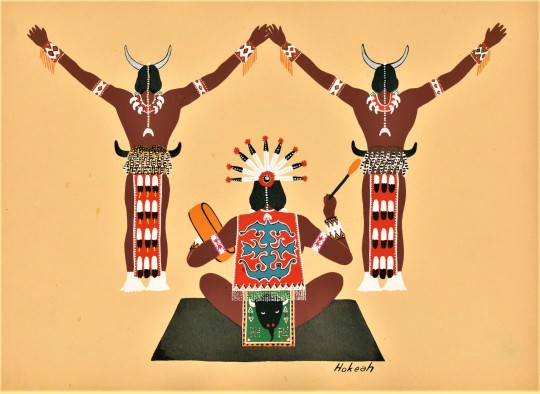

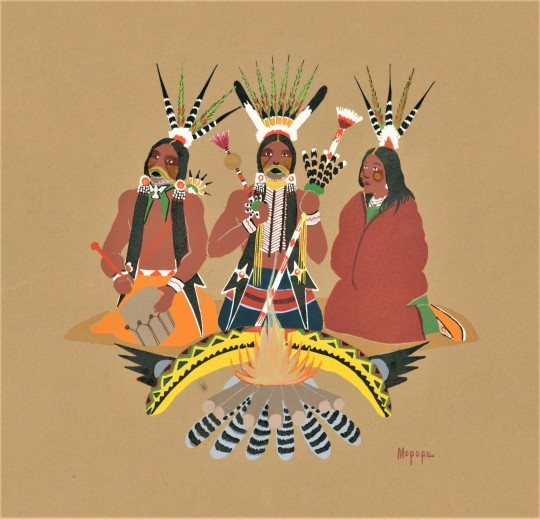
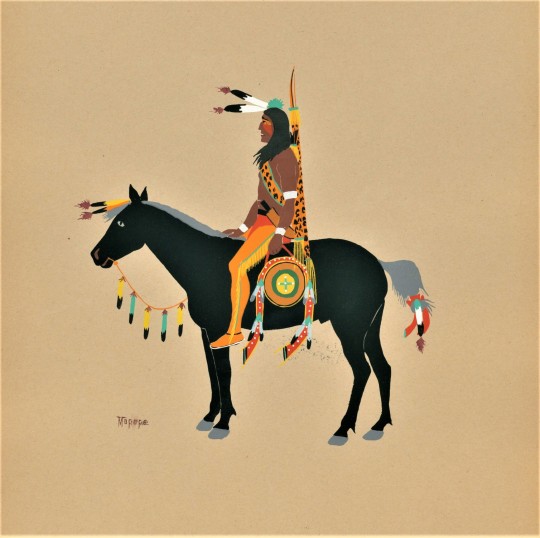
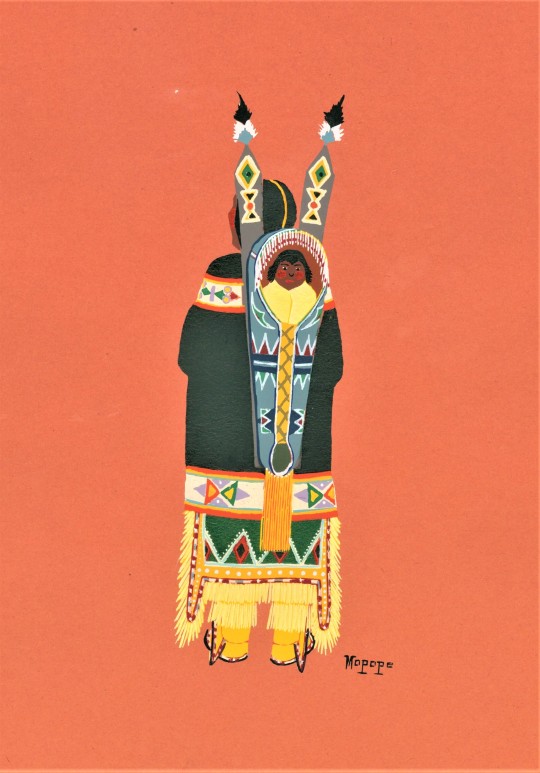
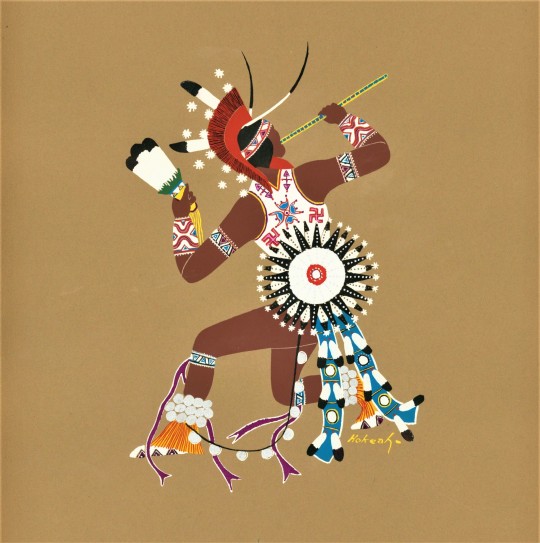
Decorative Sunday
The Nice, France-based decorative arts publisher C. Szwedzicki produced six titles on Native American Art. We’ve already presented their 2-volume portfolio Pueblo Indian Pottery, published from 1933-1936. This week we present some plates from the first of the six titles, Kiowa Indian Art, with images from the collection of Swedish-born American painter and Native American art curator Oscar Brousse Jacobson, published in 1929 in an edition of 750 copies signed by the publisher. The portfolio includes 30 color plates reproducing the paintings of the so-called Kiowa Six: Spencer Asah, James Auchiah, Jack Hokeah, Stephen Mopope, Monroe Tsatoke and Lois Smoky. The images shown here are by Asah, Hokeah, Mopope, and Smoky. Click on the images to see the attributions.
Oscar Jacobson was director of the University of Oklahoma's art department and established a special program at the school in 1926 for these promising Kiowa artists. They were provided with studio space, painting instruction, and choice exhibition venues, including the 1928 First International Art Exposition in Prague where they received international acclaim. This portfolio was produced soon after. The work of the Kiowa Six are considered significant in the development of Native American painting by bridging the era of Ledger Art to flat-style Southern Plains painting. Of the six, the work of Lois Smoky is the rarest and the most collectable as she left the program in 1927 and did not continue painting, although she later became noted as an accomplished beadworker.
View more posts on works published by C. Szwedzicki.
View other Decorative Sunday posts.
#Decorative Sunday#decorative arts#decorative plates#C. Szwedzicki#Kiowa Indian Art#Kiowa artists#Kiowa Six#Spencer Asah#James Auchiah#Jack Hokeah#Stephen Mopope#Monroe Tsatoke#Lois Smoky#Oscar Brousse Jacobson#Oscar Jacobson#Native Americans#Native American art#Native American artists
140 notes
·
View notes
Text
Sacheen Littlefeather (Apache/Yaqui/Ariz.), the Native American actress and activist who took to the stage at the 1973 Academy Awards to reveal that Marlon Brando would not accept his Oscar for The Godfather, has died. She was 75.
Littlefeather died at noon Sunday at her home in the Northern California city of Novato surrounded by her loved ones, according to a statement sent out by her caretaker. The Academy of Motion Picture Arts and Sciences, which reconciled with Littlefeather in June and hosted a celebration in her honor just two weeks ago, revealed the news on social media Sunday night.
Littlefeather disclosed in March 2018 that she had been diagnosed with stage 4 breast cancer, and it had metastasized in recent years.
Brando had decided to boycott the March 1973 Oscars in protest of how Native Americans were portrayed onscreen as well as to pay tribute to the ongoing occupation at Wounded Knee, in which 200 members of the American Indian Movement (AIM) faced off against thousands of U.S. marshals and other federal agents in the South Dakota town.
Speaking in measured tones but off-the-cuff — Brando, who told her not to touch the trophy, had given her a typed eight-page speech, but telecast producer Howard Koch informed her she had no more than 60 seconds — she continued, “And the reasons for this being are the treatment of American Indians today by the film industry … and on television in movie reruns, and also with recent happenings at Wounded Knee.”
Littlefeather’s remarks were met in the building by a smattering of boos as well as applause, but public sentiment in the immediate aftermath of her appearance was largely negative. Some media outlets questioned her Native heritage (her father was Apache and Yaqui and her mother was white) and claimed she rented her costume for the ceremony, while conservative celebrities including John Wayne, Clint Eastwood and Charlton Heston — three actors who had starred in many a Western — reportedly criticized Brando and Littlefeather’s actions.
As she was becoming an indelible part of Oscar lore, Wayne “was in the wings, ready to have me taken off stage,” she told the Los Angeles Times in 2016. “He had to be restrained by six security guards.”
Regardless, nearly 50 years later, the Academy issued her an apology.
“The abuse you endured because of this statement was unwarranted and unjustified,” then-AMPAS president David Rubin wrote to her in a letter dated June 18. “The emotional burden you have lived through and the cost to your own career in our industry are irreparable. For too long the courage you showed has been unacknowledged. For this, we offer both our deepest apologies and our sincere admiration.”
Although Brando’s stunt had the intended effect of renewing attention on Wounded Knee, Littlefeather said it put her life at risk and killed her acting career, claiming that she lost guild memberships and was banned from the industry. (In addition, the Academy subsequently prohibited winners from sending proxies to accept — or reject — awards on their behalf.)
“I was blacklisted — or, you could say, ‘redlisted,'” Littlefeather said in her documentary. “Johnny Carson, Dick Cavett and others didn’t want me on their shows. … The doors were closed tight, never to reopen.”
Littlefeather managed to appear in a handful of films (The Trial of Billy Jack, Johnny Firecloud and Winterhawkamong them) before she quit acting for good and earned a degree in holistic health from Antioch University with a minor in Native American medicine. Her work in wellness included writing a health column for the Kiowa tribe newspaper in Oklahoma, teaching in the traditional Indian medicine program at St. Mary’s Hospital in Tucson, Arizona, and working with Mother Teresa on behalf of AIDS patients in the Bay Area. She would go on to serve as a founding board member of the American Indian AIDS Institute of San Francisco.
Via The Hollywood Reporter
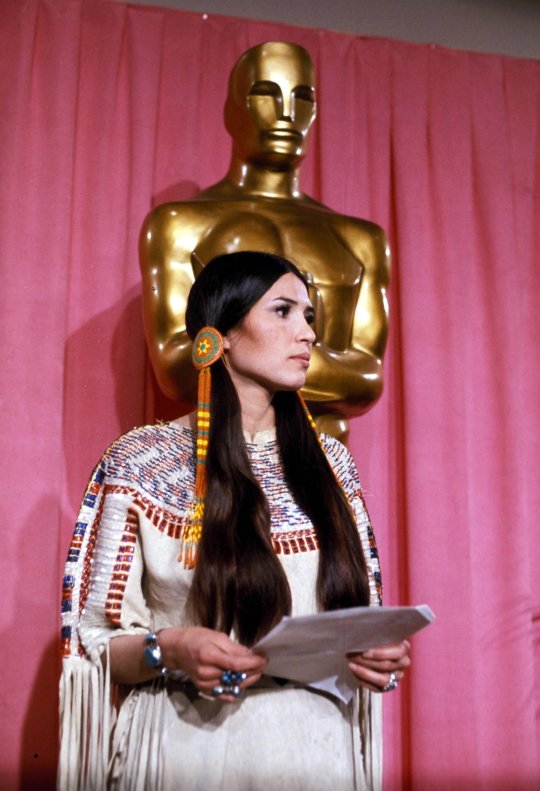
7K notes
·
View notes
Text
Silver Horn drawings, 1897-1921

Silver Horn drawings, 1897-1921
“Silver Horn (1860-1940), a Kiowa artist from the early reservation period, may well have been the most prolific Plains Indian artist of all time. Known also as Haungooah, his Kiowa name, Silver Horn was a man of remarkable skill and talent. Working in graphite, colored pencil, crayon, pen and ink, and watercolor on hide, muslin, and paper, he produced more than one thousand illustrations between 1870 and 1920. Silver Horn created an unparalleled visual record of Kiowa culture, from traditional images of warfare and coup counting to sensitive depictions of the sun dance, early Peyote religion, and domestic daily life. At the turn of the century, he helped translate nearly the entire corpus of Kiowa shield designs into miniaturized forms on buckskin models for Smithsonian ethnologist James Mooney.”
-- Silver Horn: Master Illustrator of the Kiowas by Candace S. Greene
The artist Elbridge Ayer Burbank traveled to Indian reservations in the late nineteenth century to paint the portraits of Indigenous peoples. Burbank traveled to Fort Sill, Oklahoma, on three occasions; it was there that the Kiowa artist Silver Horn sat for him for at least two portraits.
Silver Horn had been an established artist among the Kiowa since the 1880s. In 1899, he became interested in Burbank’s “naturalist” technique, and he observed the American artist as he painted other subjects. With Burbank, Silver Horn studied the art of modeling faces and individual portraiture. He experimented with this style in a series of individual portraits of people and animals, most of which he sold to Edward E. Ayer, before abandoning the style in favor of work that was more stylistically Kiowa.
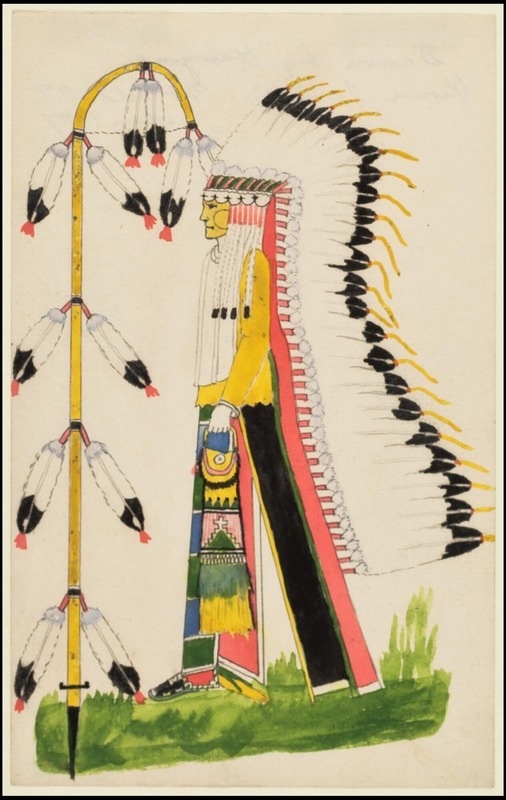
Silver Horn drawings, 1897-1921
The 123 pieces by Silver Horn in the Newberry’s Ayer Collection demonstrate that his experimentation took him away from narratives about community to work that featured individuals. This makes the body of work held in the collection stylistically distinct from both the earlier and later periods of Silver Horn's work.
–former Ayer Reference Librarian Seonaid Valiant (abridged from original post)
View Silver Horn's drawings or all of the Edward E. Ayer Collection at Newberry Digital Collections
#newberry library#libraries#special collections#archives#native american history#native american art#silver horn#kiowa#collection stories
103 notes
·
View notes
Photo

This Stacked Star Tear dress was made by Cherokee artist, Tonia Hogner-Weavel. It won the Judges Choice Award at the 9th Annual Cherokee Homecoming Art Show in 2004.
The Cherokee Tear dress was adopted in 1975 as the official tribal dress for the Cherokee Nation of Oklahoma. Many believe that the tear dress originated with the ‘Trail of Tears’ death march of Eastern Cherokees to Indian Territory, what is now Oklahoma, in 1838-1839. This actually is not true. The dress was created in what appeared to be an embarrassing situation for the Oklahoma Cherokees in 1968. Virginia Stroud was chosen to be "Miss Indian America" and was crowned wearing a Kiowa style dress. A group of Cherokee women approached W.W. Keeler, Chief at the time, to talk about creating a new dress that would represent the Cherokee Nation. After extensive research for a true representative style of the Cherokees, the tear dress was designed. The name refers to the actual tearing, not cutting, of cloth to make the dresses.
#Native American Heritage Month#Native American Art#Tonia Hogner-Weavel#Cherokee Art#Cherokee#Stacked Star Tear Dress#Cherokee dress
25 notes
·
View notes
Text

Moonbeam has appeared frequently in another of my blogs, Women In Charge, in fm bondage interpretations of covers to the Swedish language comic Solvpilen, or Silver Arrow. The character is a somewhat stereotypical female Native American who is sister and sidekick to the Silver Arrow of the title, wise and brave chief of the Kiowa. Although very sexualised, and frequently illustrated in damsel in distress scenarios, Moonbeam is nonetheless skilled in unarmed combat and not infrequently comes to Silver Arrow’s rescue also. Dressed in a tight, flowing, slit buckskin dress, Moonbeam often graced the cover of Solvpilen, frequently depicted throwing sundry outlaws, Indians and renegade cavalry troopers over her shoulder. She is therefore very much of her late 1970s/1980s time - a strong but not too strong female character, feisty and able to look after herself, but fundamentally subservient to the main man. Moonbeam is therefore not the best example of a strong female comic book character, but her kick-ass abilities do earn her a place in this blog.
The above cover is somewhat atypical in that Moonbeam is shown in customary jiu-jitsu mode, but her garb is less sexy and more realistic. There is also the slightly surreal addition of the warrior maiden’s pet mountain lion cub, Tinka, who accompanies Moonbeam everywhere and never seems to grow up.
The title began as Zilverpijl, a Flemish language creation of the Belgian artist Frank Sels in 1970, which rapidly gained popularity in the whole Scandinavia (including Finland), and was also translated into German. The series ran until 1986 but never broke into the English language comic book world which is a shame, as its stories were well plotted, contained much factual information about Native American life, and the cover art in particular, was very dynamic.
The cover featured is to Solvpilen #1 (January 1972)
#women in comics#strong woman#solvpilen#moonbeam#silver arrow#Frank Sels#westerns#female native american warrior
6 notes
·
View notes
Photo
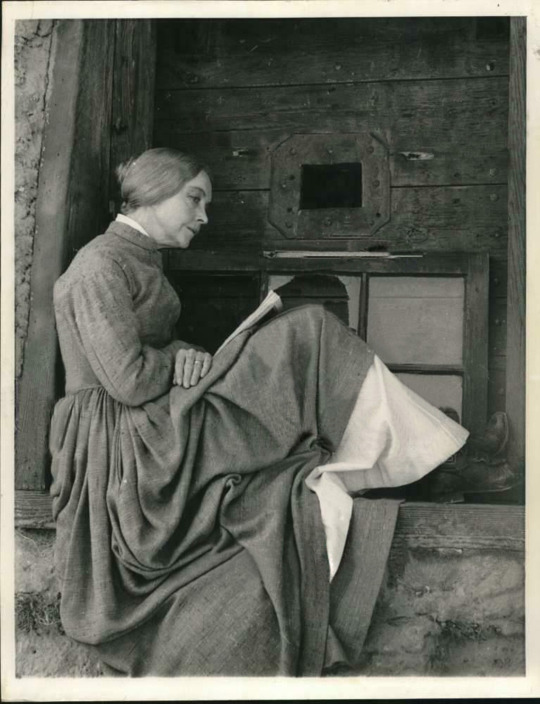
The Unforgiven 1960 (Photo - Lillian Gish behind the scenes - Durango Mexico - filming The Unforgiven (Matilda Zachary))Late in 1958, Huston signed a contract to direct a Western for the production company of Hecht-Hill-Lancaster, whose first big hit had been the Academy Award-winning Marty. The film would star Burt Lancaster and be based on the novel The Unforgiven by Alan LeMay. Huston and Ben Maddow, with whom he had written The Asphalt Jungle, began the adaptation. To save money, the film, set in the western United States in the late 1860s, would be shot near Durango, in Mexico, a country that Huston knew well and felt happy working in.In an interview with the Hollywood Citizen-News in 1959, Huston announced, “In The Unforgiven . . . the gross salary of any of the stars — Audrey Hepburn, Tony Curtis, Burt Lancaster— is more than the entire cost of The Maltese Falcon, which was made for less than $300,000.“ Curtis would drop out of this cast and be replaced by Audie Murphy, but the cost of the film would not drop. It would eventually hit more than $5,000,000, making the project the most expensive Huston had done to that point in his career. There were a number of reasons for the expense. One involved a long delay that occurred when Audrey Hepburn was injured falling from a horse — a recurrent danger in Huston films because of the director’s insistence upon using horses — and had to be hospitalized with a bad back. Another major expense was the house that had to be constructed. There are only two apparently simple houses in the film, one in which the Zachary family (Lancaster, Hepburn, Murphy, Lillian Gish, and Doug McClure) live and the other in which the Rawlins family (Charles Bickford, Albert Salmi, June Walker, Kipp Hamilton, and Arnold Merritt) live. The Zachary house, however, proved to be one of the most expensive sets Huston ever had made. Built against a fake mountain that itself had to be constructed, the house was made in specially fitted sections so it could be taken apart easily for shots at various positions. It was a marvel of engineering, supervised by art director Stephen Grimes. “The house,” said Huston, “was almost as ingenious as the whales built for Moby Dick. It served as a studio as well as our main set because we did our film cutting right there, in the back of the house under the artificial hill.” After each day of shooting, the color film would be flown to England for processing and then flown back to be viewed by Huston. In the finished film, which runs over two and a half hours in its uncut form, the Zachary family, led by the eldest brother, Ben (Lan- caster), is in partnership with the Rawlins family in cattle ranching. The Zachary father had been killed in a Kiowa attack and the Zacharys — particularly Cash (Murphy) — bear a deep hatred for the Indians. A mysterious figure, Kelsey (Joseph Wiseman), dressed in a Union uniform arrives one day and tells the Indians and then the Rawlins family that Rachel Zachary (Hepburn) is really a full-blooded Kiowa. The Zacharys admit that she is a foundling but deny she is Indian. When the oldest Rawlins boy, Charlie (Albert Salmi), is killed by the Kiowa after he courts Rachel, Kelsey is brought in to be hanged for helping the Indians. He again insists that Rachel is an Indian and that he had been with the dead Zachary father when the child was found. The Zacharys deny this and refuse to allow Rachel to be examined. Zeb Rawlins (Bickford) renounces his partnership and sends the Zachary family off alone to fight the Kiowas, who have vowed to take Rachel. The Zacharys find an Indian message indicat- ing Kelsey’s story is true. Mattilda (Gish) admits the truth, and Cash denounces Rachel and leaves. The Zacharys then fight the Indians through the night. Mattilda is killed and Andy (McClure) wounded. Cash returns to help at the last minute, and Rachel kills her own brother, the Indian who has led the war party to get her. Ben announces his plan to marry Rachel and the film ends. The similarity to Huston’s other films can be seen in the search for a truth hidden in the past, a truth that reveals someone has been posing as something he or she is not. This recurrent Huston theme was to be developed even more explicitly in Freud and The List of Adrian Messenger. Again, a small group must stand alone against great odds and risk their lives for a goal or principle, for the first time in a Huston film a principle that involves a group of people held together by racial prejudice. The film is filled with Biblical dialogue and Old Testament refer- ences. “The Lord sayeth, be fruitful and multiply,” says the patriar- chal Zeb. This verselike Biblical prose was to be used even more in Huston’s only other Western, The Life and Times of Judge Roy Bean. There is a strange undercurrent of mysticism in the film. Cash, for example, has special powers and is able to sense the presence of Indians. During the siege of the family house, when he is ten miles away, he tells the Rawlins’ daughter (Walker) exactly what is hap- pening. Kelsey appears as a prophet out of the mist to forecast doom just as Elijah (Royal Dano) in Moby Dick did before the voyage, but still the characters move forward, committed to their path. While the film does adhere to conventions of the Western in many ways, it also introduces some rather bizarre touches. The ghostly presentation of Kelsey throughout the film is one example, but the use of the piano may be even more striking. Ben brings a piano back home from Wichita so that Mattilda can play Mozart. When the Indians play their war flutes — not drums — in the night during the seige, Ben moves the piano outdoors and his mother counters with light classics. The image is surreal and followed by an equally strange sequence in which six Indians are killed in a frenzied attack on the piano. Unfortunately, while reviews were mostly good, The Unforgiven was not popular with audiences. At this point, Huston had made three films away from his home in Ireland and had thoughts about heading back there to work on his Freud project, but he was to be delayed for almost two more years by a film that took him back to the United States.
4 notes
·
View notes
Text
UNC-Chapel Hill's Kunstmuseum stellt Native American Kunst in den Mittelpunkt einer neuen Ausstellung
Bild: "Indian Gathering," ein Ölgemälde des Kiowa-Künstlers Stephen Mopope aus dem Jahr 1933 ist Teil der Wanderausstellung des Gilcrease Museums, die indianische Kunst zeigt.
Am 16. Februar wurde im Ackland Art Museum der UNC-Chapel Hill eine neue Ausstellung zur Kunst der Native Americans eröffnet.
Die Wanderausstellung mit etwa 75 Werken trägt den Titel Past Forward: Native American Art aus dem Gilcrease Museum. Das Gilcrease Museum in Tulsa, Oklahoma, besitzt eine Sammlung, die größtenteils von dem verstorbenen Thomas Gilcrease, einem Mitglied der Muscogee Nation, aufgebaut wurde.
Das Ackland ist der erste von drei Ausstellungsorten in den USA, an dem die Wanderausstellung gezeigt wird.
Ein Ölgemälde auf Leinwand zeigt eine Menschenmenge, die sich in einer Reihe aufstellt. Viele tragen grüne Kopfbedeckungen. Die Landschaft besteht aus Bergen im Hintergrund und lehmähnlichen Gebäuden. Mit freundlicher Genehmigung des Ackland Art Museum / Gilcrease Museum 1940 malte der Hopi-Künstler Fred Kabotie "Pueblo Green Corn Dance". Laut Peter Nisbet, dem stellvertretenden Direktor des Ackland Art Museums für kuratorische Angelegenheiten, umfasst die Ausstellung alte und zeitgenössische Kunstwerke von verschiedenen Stämmen, wie den Kiowa und Cherokee. Einige europäisch-amerikanische Kunstwerke sind ebenfalls Teil der Ausstellung, so Nisbet, um einen Dialog über den kulturellen Austausch zu fördern.
Die Sammlung ist nicht nach Künstlern oder Zeitabschnitten geordnet, sondern nach vier Konzepten: Zeremonie, Souveränität, visuelle Abstraktion und Identität.
"Es gibt viele Einstiegspunkte in diese Ausstellung, und das ist, glaube ich, eine ihrer Stärken", so Nisbet. "Es gibt diese Themen, über die wir sprechen. Es gibt die einzelnen Objekte selbst, die atemberaubend schön sein können. Das Ackland denkt auch über seine eigene Auseinandersetzung mit der Kunst der amerikanischen Ureinwohner nach. Es ist eine reichhaltige Ausstellung.
In der Ausstellung sind Stücke zu sehen, die Tausende von Jahren alt sind, wie ein schmetterlingsförmiger Bannerstein, der auf mindestens 1000 v. Chr. zurückgeht. Etwa ein Viertel der Ausstellung besteht aus Werken, die in den letzten 50 Jahren entstanden sind, so Nisbet.
"Moderne indianische Künstler unserer Zeit haben bewusst auf frühere Traditionen zurückgeblickt, um sie wiederzubeleben, um so ein kontinuierliches Gespräch mit der Vergangenheit zu führen", so Nisbet. "Der Titel der Ausstellung soll darauf anspielen."
Ein Tempera-auf-Papier-Kunstwerk, das acht Menschen zeigt, die in einer Reihe stehen - vier im Vordergrund, vier im Hintergrund. Sie tragen kunstvolle Masken und farbenfrohe Kleidung (Gilcrease Museum)
Waldo Mootzka, Hopi, 1903 - 1938, Bohnentanz, frühes 20. Jahrhundert, Tempera auf Papier. Gilcrease Museum, Tulsa, OK.
Mit der Ausstellung im Ackland will das Museum unter anderem die Bekanntheit von Künstlern des Mittleren Westens erhöhen, die an der Ostküste weniger bekannt sind.
"Die Ausstellung selbst soll zeigen, dass die Kunst der amerikanischen Ureinwohner nicht nur eine Facette der amerikanischen Kunst ist", so Nisbet. "Sie ist in gewisser Weise eine eigene Tradition. Sie hat ihre eigenen Stärken, ist aber auch ein wesentlicher Teil der breiteren Geschichte".
Nisbet hofft, dass die Werke durch die Auseinandersetzung mit den Themen der Ausstellung beim Publikum an der Universität und im ganzen Bundesstaat Anklang finden, vor allem wenn man bedenkt, dass North Carolina die größte indianische Bevölkerung östlich des Mississippi hat. Hier leben die Occaneechi Band of the Saponi Nation, die Coharie, die Eastern Band of Cherokee Indians, die Haliwa-Saponi, der Lumbee Tribe of North Carolina, die Meherrin, die Sappony, die Waccamaw Siouan und die Tuscarora.
Zusätzlich zur Wanderausstellung wird das Ackland seine eigene Sammlung indianischer Kunst zeigen und interaktive Programme wie Führungen und wissenschaftliche Vorträge anbieten.
Originalartikel
Das könnte Sie auch interessieren
Read the full article
0 notes
Text
THE KIOWA FIVE
The Kiowa Five (or Six) stepped beyond ledger art to develop a distinctive style that continues to influence Indian artists
By LES KRUGER 11/25/2015
Picture of many works of these artists are online . At the Khan Academy there's a presentation of a series of murals by the eldest of the artist, Stephen Mopope: Stephen Mopope, U.S. Post Office Murals, Anadarko, OK.
0 notes
Text

T.C. Cannon,T.C. Cannon: At The Edge of America (Salem, Massachusetts: Peabody Essex Museum, 2018). Plate numbers 16 and 12:Waiting for the Bus(Anadarko Princess), N.D., 1982, color lithograph on paper and Self-Portrait in the Studio, 1975, oil on canvas
T.C. Cannon (1946–1978) was an enrolled member of the Kiowa Tribe with Caddo and French ancestry. A multidisciplinary artist working during the turbulent 1960s and 1970s, Cannon was featured with fellow artist Fritz Scholder (1937–2005) in the Smithsonian Institution's National Collection of Fine Arts 1972 exhibition,Two American Painters. In this transformative exhibition, Cannon and Scholder overturned visual stereotypes about Native Americans exploring irony and kitsch to convey socio-political messages. The catalog above is part of a recent travelling exhibition organized by the Peabody Essex Museum in Salem, Massachusetts which then went on to the Smithsonian National Museum of the American Indian in New York and the Gilcrease Museum in Tulsa, Oklahoma. It includes over eighty of Cannon’s paintings, prints, and drawings alongside his poems and song lyrics, as well as newly published personal ephemera, photographs, and handwritten and typed manuscript pages.
0 notes
Text
Maquette level 2

Maquette level 2 Pc#
This gesture of giving is not only typical of my people but is also a personal gesture to this city, which has been so kind to me. “To the City of Wichita, KS, and all its people, it is with extreme pleasure and pride that I give this sculpture “Keeper of the Plains. Blackbear assumed leadership in both Indian and civic affairs.īlackbear Bosin spoke at the dedication of his sculpture: By the 1960s Blackbear’s work was being recognized nationwide and he opened his own Wichita enterprise, the Great Plains Studio. In 2011 Lemoore showed it off at the Game Developers Conference in San Francisco, where Kotaku received a firsthand look. As he recovered his own past, he translated that history into paintings, which he exhibited at regional exhibitions such as the annual Indian Art Exhibit at the Philbrook Art Center in Tulsa, Oklahoma. Maquette spent about a decade in the oven. The Gateways is the second level of Maquette, and it’s when the systems get a lot more complicated. In the 1950s Blackbear began to polish his technical skills and to immerse himself in the history and beliefs of the Plains and Southwestern Indians. Solve all the gem puzzles in The Gateways with our complete solutions guide. Artist friends encouraged him to become a serious painter. Marine Corps during World War II, he returned to Wichita in 1946 to take a job as a commercial artist. However, his mother Ada, who was a talented bead worker, inspired her son’s interest in art, an interest, which he pursued largely on his own without formal education.īlackbear first came to Wichita in 1940 to work in the aircraft industry. The artist later reported that he had been raised in a climate of prejudice, which inhabited his early appreciation of his native cultural heritage. Keeper of the Plains caught the imagination of the Wichita American Revolution Bicentennial Commission of Wichita Festivals who adopted the sculpture project as the Bicentennial symbol for Wichita.īorn to a Kiowa father and a Comanche mother in Anadarko, Oklahoma, Blackbear (Tsate-Kongia) lived on a farm and attended St. Blackbear is best known to the public for his sculpture Keeper of the Plains, which stands at the confluence of the Arkansas and Little Arkansas rivers.
Maquette level 2 Pc#
Maquette will launch on PlayStation 5, PlayStation 4 and PC from March 2.Blackbear Bosin was a nationally acclaimed Native American artist whose art taught Wichitans about the ancient heritage of their city. You can check out a trailer for the game for yourself below. The opportunity to be active in the storytelling and have your own ability to have an impact on the eventual outcome - as a reader - was what I was drawn to." Speaking to The Hollywood Reporter of her decision to take the role, Dallas Howard said "I was always drawn to choose your own adventure opportunities. Graceful Decay has also managed to secure some top level Hollywood talent to provide voices for the game, with real-life couple Bryce Dallas Howard (of Jurassic World & Black Mirror fame) and her husband Seth Gabel (who has appeared in American Horror Story: Hotel and Fringe) to play the central couple Kenzie and Michael of the story. Objects that you manipulate or change in one version of the world will be reflected in all the others, so – for example a small key can be set across a chasm in the smaller world to become a bridge in the normal world. The debut game from new studio Graceful Decay sees you play through the complicated love story of a new couple, represented by a world in which features itself on a smaller and bigger scale recursively. Annapurna Games has announced a release date and the cast for upcoming first-person puzzle game Maquette, which will launch next month.

0 notes
Photo

Portrait of Gi-aum-e Hon-o-me-tah (Young Woman), Elbridge Ayer Burbank, 1897
#art#art history#Elbridge Ayer Burbank#portrait#Native American#American Indian#Kiowa#American art#19th century art
195 notes
·
View notes
Photo

Vanessa Paukeigope Jennings ,
“Tipi model with depiction of underwater creature Zemoguani”, 1990,
Original tipi belonged to Adalboingyato (Fair-Haired Old Man)
Courtesy the Arthur and Shifra Silberman Collection at the National Cowboy & Western Heritage Museum, 1996.27.0749
#art#design#architecture#tipi#culture#vanessa paukeigope jennings#zemoguani#adalboingyato#indian#indigenous#heritage#united states#kiowa#apache#nomad#glamping#camping
56 notes
·
View notes
Photo
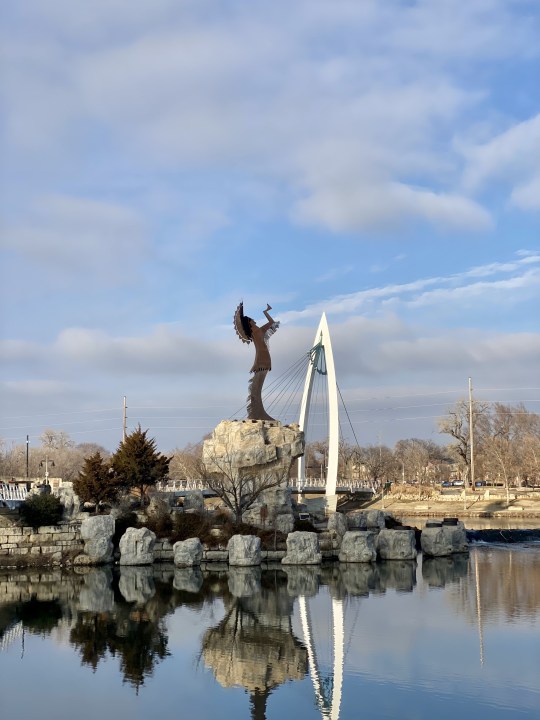
keeper of the plains, wichita, kansas
#keeper of the plains#wichita#kansas#statue#blackbear bosin#kiowa#comanche#arkansas river#little arkansas river#mid american all indian center#modern art#native american#native art#my photos#christmas 2020
5 notes
·
View notes
Photo

Inktober #27 Coat
#mima#Mima Trickster Spirit#mimatricksterspiritinvestigations#Mima: Trickster Spirit Investigations#pen#inktober#pen sketch#colored pencil#art#comic#comic art#funnies#coat#coat of arms#wolf#native american#american indian#kiowa#plains native american#tanedoah
2 notes
·
View notes
Photo

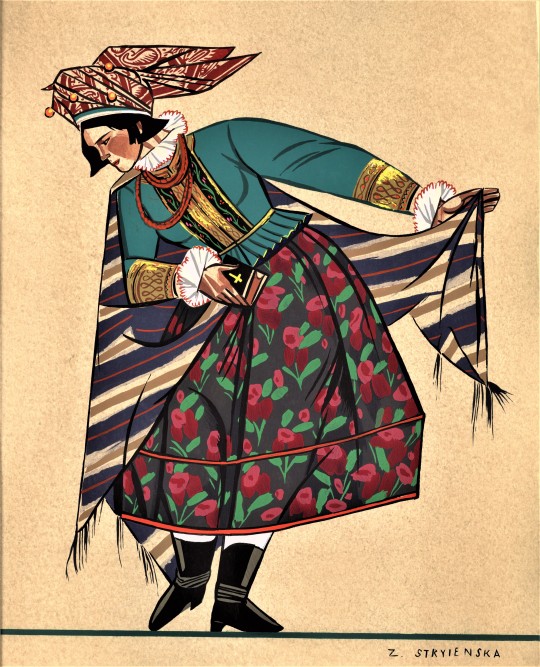


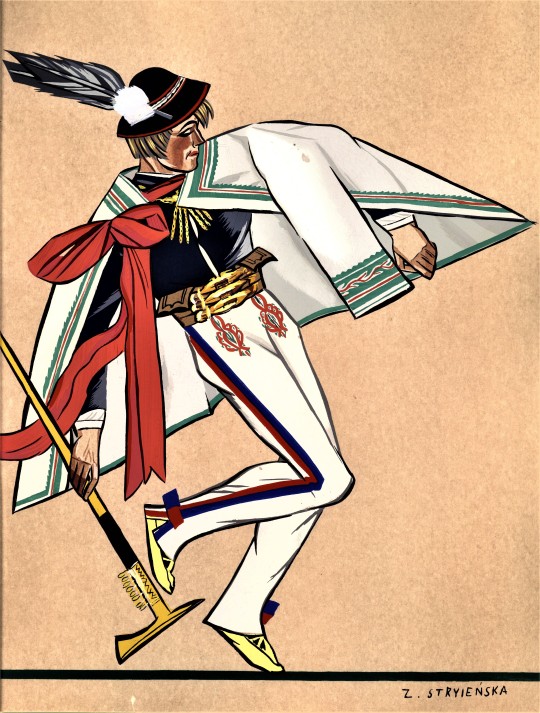

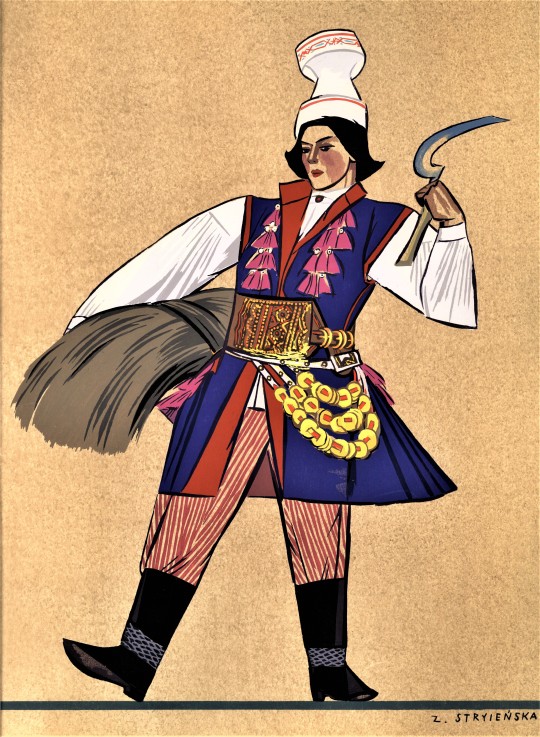

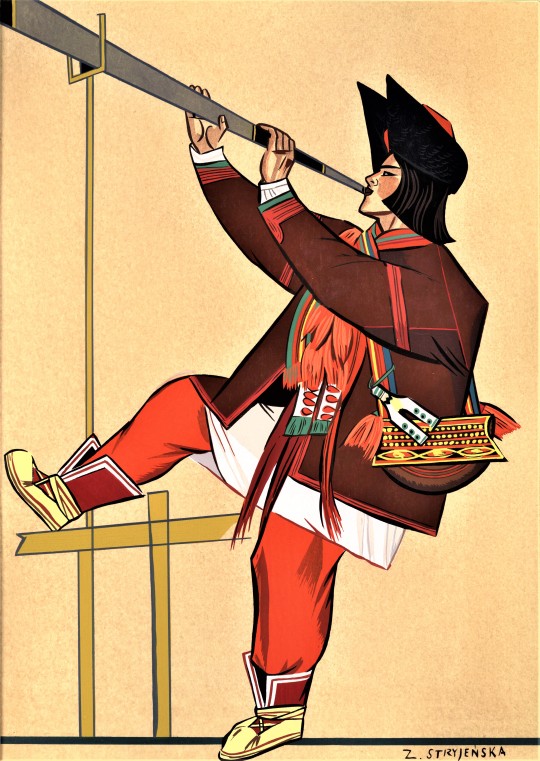
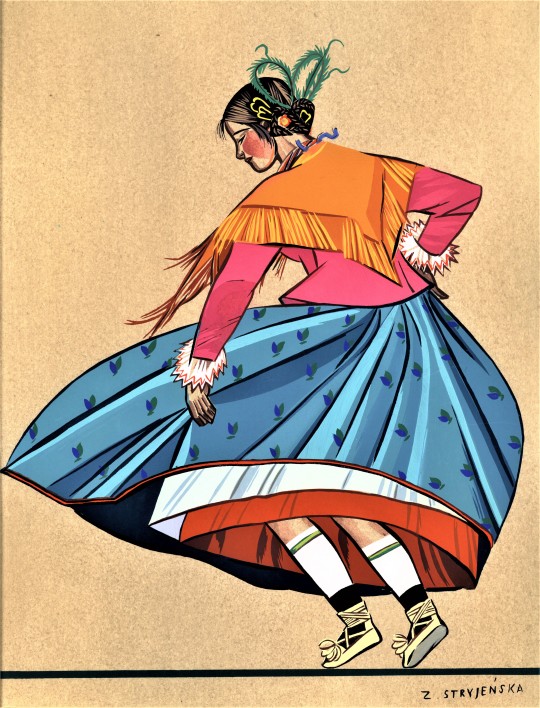
Another Folk Fashion Friday!
This week we have another great set of plates featuring folk costume, this time from Poland. Polish Peasant Costumes, published in 1939 by C. Szwedzicki in Nice, France, in an edition of 400 copies signed by the publisher, features 40 pochoir plates of paintings by Polish artist Zofia Stryjeńska. One of the most influential Polish women artists of the interwar period, Stryjeńska learned her craft at the Academy of Fine Arts in Munich, where she enrolled as a man to circumvent the proscription on women students. Stryjeńska’s works mostly utilized the tempura technique, often combining Polish folk iconography with Christian religious motif.
Very little is known about the publisher, C. Szwedzicki, including their first name. What is known is that they operated a fine arts press out of Nice, France. Szwedzicki became known to an international audience in 1929, when they published the portfolio, Kiowa Indian Art, commissioned by Swedish-American painter and curator Oscar Jacobson. Szwedzicki produced 6 volumes of Native American Art with Jacobson, but work on these volumes was interrupted when his business was seized, either by German Nazis or French Pétainists, and Szwedzicki was shipped off to Poland. Szwedzicki survived and Jacobson, with some difficulty, located him in Nice after the war as Szwedzicki worked to rebuild his business.
Polish Peasant Costumes and the 6 portfolios of Native American art produced for Jacobson are the only extant works known to be produced by this publisher, but the skill of the printing indicates a larger body a work that has likely been lost to the ravages of WWII and the march of time. Printed in 1939, Polish Peasant Costumes would have been published prior to Szwedzicki’s internment in Poland.
Included is an introduction and descriptions of the plates in English and French by Polish artist, museologist, and researcher of folk art Seweryn Tadeusz. He writes, “The costume is a child of the soil, for it is the outgrowth of the crops that are raised, of the beasts that are bred and of the means whereby raw materials are worked. Hence, it forms a part of the landscape.”
Included here, in order, are:
1. A Volhynian bride, with a headdress of woolen pompoms and tinsel from which flows a cascade of ribbon.
2. A Cracovian peasant woman with typical jerkin.
3. A Silesian peasant with the best man’s wedding wand.
4. Kasubian fisherwoman in her festive pleated bonnet.
5. A “goral,” or highlander, of the Tatra mountains.
6. A peasant woman from the Kurpie region.
7. A Cracovian farm lad with woolen bonnet.
8. A Lowicz woman in wedding wreath. The stripped cloth is characteristic of both men and women’s dress, with each neighboring village presenting a unique arrangement and color striping.
9. A Hutsul peasant from the highlands near Vorochta, blowing his long wooden trumpet.
10. A dancing highland girl.
Check out our past Fashion Friday posts. Shout out to our UWM undergrad student who stopped by the reading room to view this portfolio for a research project. If you are local to Milwaukee, come on by, we love taking your reference requests!
-Olivia, Special Collections Graduate Intern
#fashion friday#folkfashion#folk costumes#Polish Peasant Costumes#poland#polish folk costumes#zofia stryjenska#c. szwedzicki#pochoir#Seweryn Tadeusz#Oscar Jacobson#olivia
948 notes
·
View notes
Photo

tee, Wakeah Jhane (Comanche, Kiowa, Blackfeet)
#wakeah jhane#comanche#kiowa#blackfeet#tee#plains ndn#native american#american indian#indigenous#shirt#ledger art
46 notes
·
View notes